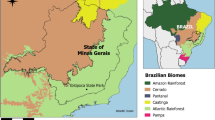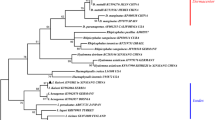Abstract
Adults of Amblyomma parvitarsum are common ectoparasites of South American camelids of the genera Lama and Vicugna, occuring in highlands of Argentina, Bolivia, Chile, Peru and also in Argentinean Patagonia. Whereas larval stages of this tick are known to feed on small lizards, host records for the nymphal instar have remained unreported. Supported by morphological and molecular analyses, herein we report A. parvitarsum nymphs parasitizing two Liolaemus species (Reptilia: Squamata) in the Andean Plateau of Argentina and Chile. Additionally, by a PCR screening targetting gltA and ompA genes, DNA of Rickettsia was detected in one of the collected nymphs. Obtained sequences of this agent were identical to a recent Rickettsia sp. described infecting adults of this tick species in Chile and Argentina.


Similar content being viewed by others
References
Altschul SF, Gish W, Miller W, Myers EW, Lipman DJ (1990) Basic local alignment search tool. J Mol Biol 215:403–410
Cabrera AL (1994) Regiones fitogeográficas argentinas. In: Kugler WF (ed.) Enciclopedia argentina de agricultura y jardinería, Tomo 2. 2a edición. 1a reimpresión. Acme. Buenos Aires. Argentina. Fascículo 1. pp 1–85
Castillo GN, González-Rivas CJ, Villavicencio HJ, Acosta JC, Nava S (2015) Primer registro de infestación en un reptil por larvas de Amblyomma parvitarsum (Acari: Ixodidae) en Argentina. Cuad Herpetol 29:91–93
González-Acuña D, Venzal JM, Fabry M, Guglielmone AA (2004) Liolaemus jamesi (Boulanger, 1891) (Reptilia: Tropiduridae), a host for the larva of Amblyomma parvitarsum Neumann, 1901 (Acari: Ixodidae). Syst Appl Acarol 9(1):33–36
Guglielmone AA, Estrada-Peña A, Keirans JE, Robbins RG (2004) Las garrapatas (Acari: Ixodidae) de la region zoogeográfica neotropical. Ediciones INTA, Buenos Aires
Labruna MB, Whitworth T, Horta MC, Bouyer DH, McBride JW, Pinter A, Popov V, Gennari SM, Walker DH (2004) Rickettsia species infecting Amblyomma cooperi ticks from an area in the state of São Paulo, Brazil, where Brazilian spotted fever is endemic. J Clin Microbiol 42:90–98
Mangold AJ, Bargues MD, Mas-Coma S (1998) Mitochondrial 16S rDNA sequences and phylogenetic relationships of species of Rhipicephalus and other tick genera among Metastriata (Acari: Ixodidae). Parasitol Res 84:478–484
Martins TF, Labruna MB, Mangold AJ, Cafrune MM, Guglielmone AA, Nava S (2014) Taxonomic key to nymphs of the genus Amblyomma (Acari: Ixodidae) in Argentina, with description and redescription of the nymphal stage of four Amblyomma species. Ticks Tick Borne Dis 5(6):753–770
Muñoz-Leal S, González-Acuña D, Beltrán-Saavedra LF, Limachi JM, Guglielmone AA (2014) Amblyomma parvitarsum (Acari: Ixodidae): localities, hosts and host-parasite ecology. Exp Appl Acarol 62(1):91–104
Need JT, Dale WE, Keirans JE, Dasch GA (1991) Annotated list of ticks (Acari: Argasidae, Ixodidae) reported in Peru: distribution, hosts, and bibliography. J Med Entomol 28(5):590–597
Nieri-Bastos FA, Szabó MP, Pacheco RC, Soares JF, Soares HS, Moraes-Filho J, Dias RA, Labruna MB (2013) Comparative evaluation of infected andnoninfected Amblyomma triste ticks with Rickettsia parkeri, the agent of anemerging rickettsiosis in the New World. Biomed Res Int 2013:402737. doi:10.1155/2013/402737
Núñez H, Fox SF (1989) Liolaemus puritamensis, a new species of iguanid lizard previously confused with Liolaemus multiformis (Squamata: Iguanidae). Copeia 1989:456–460
Ogrzewalska M, Nieri-Bastos FA, Marcili A, Nava S, González-Acuña D, Muñoz-Leal S, Ruiz-Arredondo I, Venzal JM, Mangold A, Labruna MB (2016) A novel spotted fever group Rickettsia infecting Amblyomma parvitarsum (Acari: Ixodidae) in highlands of Argentina and Chile. Ticks Tick Borne Dis 7:439–442
Pincheira-Donoso D, Núñez H (2005) Las especies chilenas del género Liolaemus Wiegmann, 1834 (Iguania: Tropiduridae: Liolaeminae). Taxonomía, sistemática y evolución. Pub Ocas Mus Nac Hist Nat Chile 59:1–486
Podboronov VM, Pchelkina AA (1989) Characteristics of the transphase andtransovarial transmission of Rickettsia sibirica by ixodid and argasid ticks. Med Parazitol (Mosk) 4:14–18
Quinteros AS, Abdala CS (2007) Liolameus puritamensis Núñez y Fox, 1989 (Iguania: Liolaemidae). Cuad Herpetol 21(2):117
Regnery RL, Spruill CL, Plikaytis BD (1991) Genotypic identification of rickettsiae and estimation of intraspecies sequence divergence for portions of two rickettsial genes. J Bacteriol 173:1576–1589
Sangioni LA, Horta MC, Vianna MCB, Gennari SM, Soares RS, Galvão MAM, Schumaker TTS, Ferreira F, Vidotto O, Labruna MB (2005) Rickettsial infection in animals and Brazilian spotted fever endemicity. Emerg Infec Dis 11:265–270
Socolovschi C, Huynh TP, Davoust B, Gomez J, Raoult D, Parola P (2009) Transovarial and trans-stadial transmission of Rickettsiae africae in Amblyomma variegatum ticks. Clin Microbiol Infect 2(15 Suppl):317–318
Acknowledgments
We are grateful to and the Corporación Nacional Forestal (CONAF) for gently facilitate us the use of their installations in Parinacota. To Nicolás Fernández and Cecilia Figueroa for their valuable help during field work, and to René Muñoz Klock who provide the transport for the research team in Chile. The collection of samples in Chile was partially funded by Fondecyt Project 1130948. FBG thank the “Dirección Provincial de Biodiversidad y Secretaria de Gestión Ambiental de la Provincia de Jujuy” for the logistics and work within the Protected Area. SML was funded by CONICYT Programa de Formación de Capital Humano Avanzado, Beca Chile No 72140079.
Author information
Authors and Affiliations
Corresponding author
Rights and permissions
About this article
Cite this article
Muñoz-Leal, S., Tarragona, E.L., Martins, T.F. et al. Liolaemus lizards (Squamata: Liolaemidae) as hosts for the nymph of Amblyomma parvitarsum (Acari: Ixodidae), with notes on Rickettsia infection. Exp Appl Acarol 70, 253–259 (2016). https://doi.org/10.1007/s10493-016-0071-0
Received:
Accepted:
Published:
Issue Date:
DOI: https://doi.org/10.1007/s10493-016-0071-0




